 Facebook
Facebook
 X
X
 Instagram
Instagram
 TikTok
TikTok
 Youtube
Youtube
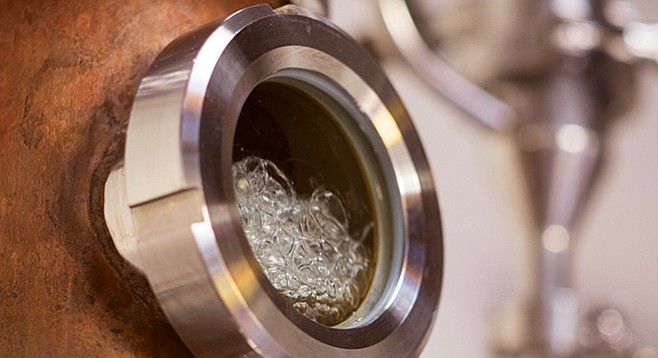
This year signaled a new era for local small-batch distillers. Assembly Bill 1295, also known as the Craft Distillers Act of 2015, went into effect on January 1, reversing archaic liquor laws that date to the early 1930s.
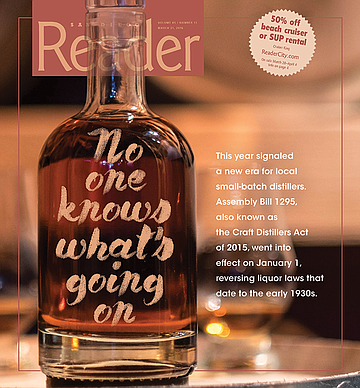
Under the Act, distillers may now apply for a license to sell up to 2.25 liters per day to customers who have participated in a tasting. The license is only available to craft liquor distillers who produce less than 100,000 gallons of distilled spirits annually with the exception of brandy, which is made from fruit and therefore falls under wine regulations. San Diego County is home to about 10 distilleries (currently operating under Type-04 license) that will be eligible to apply for the Type-74 license, along with another 120 or so throughout California.
Prior to the ruling, distillers were forbidden to sell products directly to customers due to Prohibition-era state and federal tied-house laws and California’s “three-tier” system. The system strictly separates production, distribution, and retail sales in order to prevent vertical integration (when the supply chain of a company is owned by that company), an arrangement that foments monopolies and made it possible for suppliers who operated their own distribution to report theft as a means of accounting for black-market sales. Today, the regulations serve as an outmoded hindrance to small-batch distillers.
“This historic legislation changes Prohibition-era laws for craft distillers to reflect the modern marketplace,” Assembly member Marc Levine (D-San Rafael) said in press release, “AB 1295 allows craft distillers to operate in a similar manner as wineries and breweries under existing law. This bill helps craft distillers to be competitive with large out-of-state distillers. Growth of the craft distillery industry means jobs in our local communities.”
Levine authored AB 1295, a revision of AB 1233, the latter of which contained language that could have led to legal ambiguity.
“By giving craft distillers the same privileges as wineries and breweries, thousands of jobs will be created and California brands will be able to compete in the international marketplace,” Cris Steller, executive director of the California Artisanal Distillers Guild, said in the release.
The act is a boon for local distillers, many of whom have been ramping up production in anticipation of AB1295 since it was approved by governor Jerry Brown on October 8.
“We’ll be able to make three times the profit selling in-store for the same price you’ll find in the market because of mark-ups that we have to give up for distribution,” says Bill Rogers, founder of Spring Valley tasting room Liberty Call Distilling, LLC.
It’s a warm January afternoon and Bill has 110 bottles of spiced rum ready for in-store sales on a table next to his copper still, where distiller and former neighbor Luke Oskam of Kill Devil Spirit Co. (now located near Euclid and Market) is running an experimental batch of neon-green peppermint liquor.
“At the end of the day, we’re always bottom rung,” says Luke, whose distillery was the first licensed facility in San Diego County since Prohibition. “Distributors get the most because they’re guaranteed their money regardless of whether retail makes the money back.”
“We’ve gone through a few distributors and it doesn’t matter who it is, you’re always the salesperson,” says Bill. “It’s up to you to get sales.”
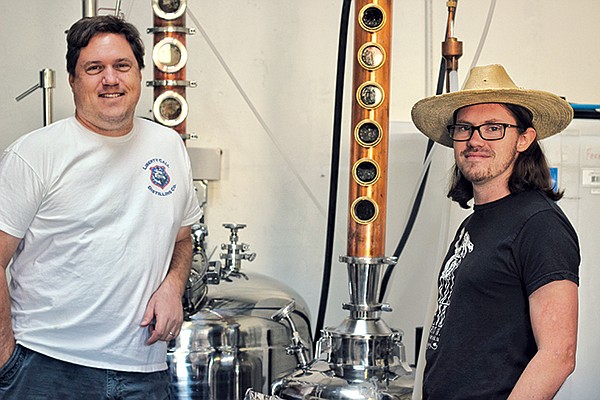
For small-batch distillers like Bill and Luke, who operate at high start-up costs with very gradual return selling a few hundred bottles a month, being able to vend spirits directly to customers not only allows them to turn a sustainable profit at prices equal to or less than retailers, it gives them the option of circumventing distributors for at least a portion of their sales. However, with the exception of San Diego Distillery and pending East Village distillery You & Yours, most distilleries continue to rely on distributors for the bulk of their sales, despite drawbacks.
“Most distributors won’t take a chance on you unless you have proof of a year of sales,” Ray DiGilio of Kill Devil told the Reader in 2014. “But you can’t apply for licensing until you have your equipment in place. So, you apply for state licensing first, then federal. Then you can run your still and make a hypothetical product, until you finally get label approval. It’s pretty easy to get a basic permit to distill, but label and formulation approvals take another year or two. The rule of thumb is, expect to be rejected the first time. The approval process is very nitpicky. The worst part about it is that you’re sitting on that equipment and plant for over a year without any revenue.”
It was with similar obstacles in mind that Casey Miles of the California Spirits Co. (San Marcos) pitched the idea of a local distribution co-operative to the San Diego Distillers Guild. The guild, made up of nine San Diego distilleries, retailers, and suppliers, rejected the idea, owing to their already tenuous relationship with distributors and the fact that the guild is focused primarily on public awareness. Regardless, Casey pushed ahead to form a co-op of six distillers who provide cross-promotional pamphlets to clients, buy supplies collectively in bulk, and share space on a homemade display case designed to highlight local spirits at retail shops.
Bill has one such wooden-crate case in Liberty Call’s utilitarian tasting room.
“We hit up all the major chains with these,” Bill says. “Instead of having to hit up six different suppliers with six different orders, they can just go through the co-op, get everything in one package, have information on everybody, with a display case for free. We still have to go through distributors, and they like it because now they have one package to deliver.”
The co-op also makes packages for bars to easily stock a full variety of spirits from local distillers.
“The other distillers in this region aren’t my competition; Bacardi is, or Captain Morgan,” Bill notes. “Kill Devil isn’t my competition.”
The next legal hurdle that distillers face is being able to distribute their own products without having to win over the compliance of a major distributor.
“I think it would benefit distributors to allow us to self-distribute, because they don’t want us anyways,” Bill says. “I could start out of the back of my car locally, but if I get big enough where I need to hire more guys to deliver or drive all the way up to L.A., I don’t want that. I want to build my own base distribution and hand it off to the distributors from there, with a guaranteed quantity per month.”
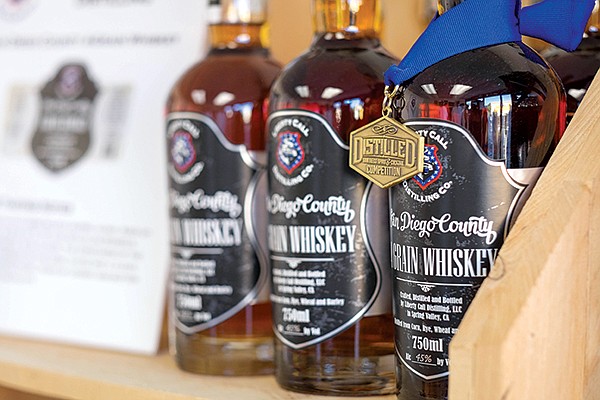
Bill pours me a taster of four-grain whiskey. A couple of years ago, this would have been illegal. It wasn’t until Assembly Bill 933 went into effect at the turn of 2014 that craft distillers were allowed to offer up to six quarter-ounce tasters (or no more than an ounce-and-a-half in total, either as individual tastes or, as of January 1, a mixed drink[s] for both Type-04 and Type-74 license holders) per customer per day. Prior to AB 993, burgeoning distillers had no way of proving to distributors that their products had enough following to sustain sales, because the general public had no way to legally taste them.
Archaic legal paradoxes such as these still riddle the artisanal spirits industry.
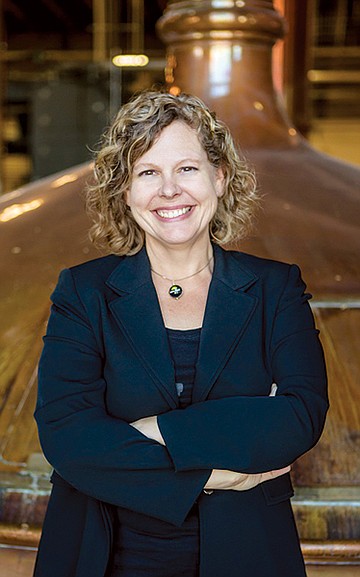
“The way the [California Alcoholic Beverage Control] works, it’s a permissive document,” explains Candace L. Moon, Esq., aka the Craft Beer Attorney, who is helping the San Diego Distillers Guild navigate the complex legal terrain surrounding their business. “If it doesn’t directly say you can do something, then you can’t. For example, it directly permits distillers to donate alcohol to nonprofits, but not merchandise. So, it’s illegal to give a T-shirt to a nonprofit, simply because no one has gotten around to changing the law. There are a lot of inconsistencies, just because of the process for changing the law. I think it confuses people who are trying to follow the law. It doesn’t seem to make sense, but that’s how it is.”
Another such ambiguity, according to this interpretation of the Department of Alcoholic Beverage Control code, is that the law requires customers to taste liquor before buying, simply because the wording indicates that spirits may be bought directly from the distillery as part of a tasting. Whether these minutiae of the law will be enforced has yet to be seen.
“What’s happened since the 1930s is that the code has been tweaked here and there along the way without any sense of the big picture,” Moon says. “So, things that are fine for a winery or a brewery may not be okay for distilleries. Where you see craft brewing now, you’ll see distilling in 10 or 20 years, specifically in California. Twenty years ago, exception was carved out for wine tasting rooms not to adhere to health code, because they were not serving food. Craft beer has had to do the exact same thing, and distilleries will likely have to do the same.”
The Craft Distillers Act of 2015 contains guidelines for craft distilling license holders to participate in nonprofit tasting festivals as well as modifications to tied-house restrictions, guidelines for establishing an on-premises eating establishment, stipulations for providing outside alcohol, and a grandfather clause granting all recipients of the license “craft distiller” status even if production later exceeds 100,000 gallons a year.
Of the craft distillers act, Moon remarks: “Honestly, I was amazed that this got passed and that the wholesalers let it go through.”
Bundled in with AB 1295 was AB 893, which streamlines the label-application process, and AB 780. Authored by Assembly member Das Williams (D-Santa Barbara), AB 780 allows alcoholic beverage producers to identify retailers of their product on social media. Before January 1, distillers were forbidden from communicating directly to customers where to buy their products, with the exception of responding to direct inquiries, though they’d still have to name multiple retailers in order to avoid showing favor to one. The post-Prohibition laws were initially put into place to protect smaller producers from bigger brands in terms of advertising, but serve the opposite outcome in the modern environment of social media advertising. Under AB 780, producers no longer need to be responding to a direct customer inquiry to post about retailers on social media, but posts must include multiple retailers to avoid showing favoritism and may only include the name and contact information of the retailer. Retail prices may not be included.
Another bizarre vestige of Prohibition-era law is made evident when I ask Bill where I can buy his spirits in a particular neighborhood of San Diego. Instead of replying, he points to a sign listing 25 or so retailers countywide.
“I can’t tell you where to buy my spirits, but as long as I list more than two, I can have a sign,” Bill says. “I can’t show a preference.”
In lieu of verbally listing retailers and risking implied favoritism, distillers still rely on printed signs such as Bill’s, though AB 1295 makes this a moot point within the confines of the tasting room, where licensed distillers may now vend their spirits directly to customers. To further circumvent the issue, many distillers already have retailers listed online in databases searchable by zip code.
What’s more, even the stipulation that craft-distiller-license applicants must manufacture less than 100,000 gallons annually is riddled with ambiguity, Luke notes.
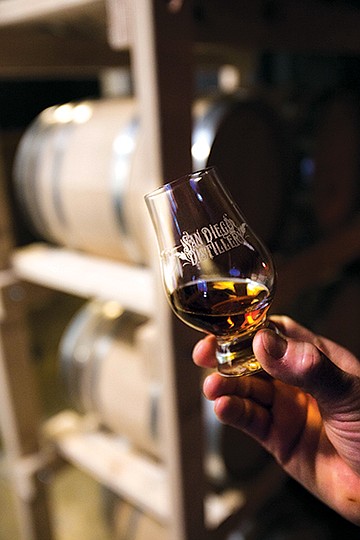
“What counts as manufacturing? A lot of distilleries are bringing in spirits and they might run it through their still once, or they might just straight up bottle it up and put it out as their own. Define manufacturing, because us [Kill Devil], Liberty Call, and Trent over at San Diego Distillery, we’re all making stuff from scratch. Others will bring in bases and distill it, other people are sending it straight to bottle or barrel. How nitpicky do you want to be about manufacturing? Where’s the cutoff point, and who defines that? It hasn’t been established yet. It’ll be one precedent at a time.”
The [bureau of Alcoholic Beverage Control] doesn’t have the budget for random checks, Bill adds, and typically comes down on an establishment after complaints, so clarification via case-by-case precedents may be a lengthy process. It doesn’t make much difference to Bill and Luke, who manufacture everything from scratch, but they acknowledge that the vagueness may come back to bite other producers, as it’s not uncommon for distillers to both make their own spirits and rebottle or minimally process outside spirits, depending on the final product.
“If you see a four-year bourbon from a two-year-old distillery, well, you can do the math,” Bill says.
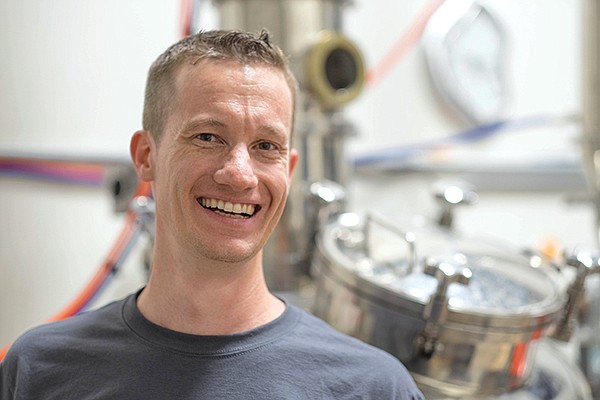
Located across Via Orange Way in the same Spring Valley industrial park as Liberty Call, Trent Tilton has his own batch of bourbon aging in charred oak barrels. Trent is in a unique position among local distillers.
“My model was already based on direct sales,” says Trent, who plans to opt out of distribution. “I got into this expecting to be able to do this, but not until a year or two later. I’m producing all whiskeys, because I can let it sit. I started barreling right after I got my license in May. I’m always filling and emptying barrels. I’m kind of the oddball because I came from the craft-beer world, really small batch. I plan on doing one-off barrels. It’s a totally different model. Some people think I’m crazy for doing all whiskey, but what can I say? I love it.”
San Diego Distillery is located behind the former headquarters of Kill Devil (now the site of distillers Del Sol.) With a third distillery slated to move into the same compound soon, the Spring Valley hub is positioned to become a prominent craft-spirits destination. It’s lodged comfortably between West County tasting rooms such as Old Harbor Distillery Co. and East County distillers Twisted Manzanita and BNS. Bill notes that the location is favorable because permitting and liability is less stringent through the county.
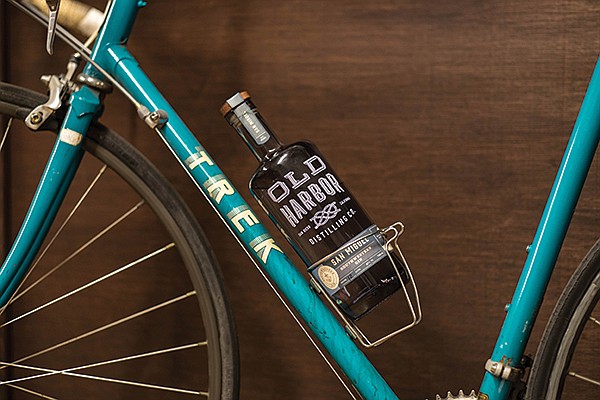
“The reason I went out to Spring Valley is that it’s an unincorporated part of San Diego County; it has really loose regulations, compared to the City of San Diego,” Bill says. “Old Harbor blazed the trail for everybody. They had all sorts of trouble with the city.”
Old Harbor distiller and guild founder Michael Skubic continues to grapple with legal ambiguity at his East Village distillery.
“No one knows what is going on,” he says. “These new laws aren’t even in stone yet. They have not written how they plan to enforce them.”
Even so, local spirit drinkers have already embraced his efforts with open arms.
“We have been fortunate to find favor among the babes in toyland that are the bartending community,” says Michael. “I like to drink at their establishments, they seem to like my spirits, or at least are nice enough to say they do, and there is an abundance of talent in this city. It’s truly underrated as a foodie or drinkers’ destination.”
“San Diego is leading the scene in California, similar to Portland or Seattle,” Bill says, adding that the ability to have a commercial kitchen under AB 1295 will invite new opportunities for craft distillers. “Now you’re going to probably see all of these distillery brewpubs or distill pubs that can carry beer, wine, and spirits from other producers as long as they’re purchased through a distributor.”
Is San Diego on the brink of a micro-distilling boom?
“I’d say it’s definitely coming but not necessarily speeding towards us,” says Laura Johnson, proprietor of East Village’s nascent You & Yours Distilling Co. and industry writer at distillerista.com.
“The craft-beer industry no doubt paved the way for craft liquor, and I’m sure that’s why San Diego already has so many craft distillers, but it’s still difficult to get people to buy spirits. The average American buys something like two 750 mL bottles of spirits a year but you can go into a brewery and have five or six beers in one visit. As distillers, our uphill battle is a bit steeper. That said, it’s incredibly exciting and encouraging to know that I’m jumping into an industry in which the golden years are still ahead of us. Even though there are so many incredible American distillers who have been doing amazing things for years, I’m still an early adopter. I do think we can expect to see more distilleries pop up in San Diego County. The culture here is super loyal and so deeply tied to local, so it’s very appealing.”


This year signaled a new era for local small-batch distillers. Assembly Bill 1295, also known as the Craft Distillers Act of 2015, went into effect on January 1, reversing archaic liquor laws that date to the early 1930s.

Under the Act, distillers may now apply for a license to sell up to 2.25 liters per day to customers who have participated in a tasting. The license is only available to craft liquor distillers who produce less than 100,000 gallons of distilled spirits annually with the exception of brandy, which is made from fruit and therefore falls under wine regulations. San Diego County is home to about 10 distilleries (currently operating under Type-04 license) that will be eligible to apply for the Type-74 license, along with another 120 or so throughout California.
Prior to the ruling, distillers were forbidden to sell products directly to customers due to Prohibition-era state and federal tied-house laws and California’s “three-tier” system. The system strictly separates production, distribution, and retail sales in order to prevent vertical integration (when the supply chain of a company is owned by that company), an arrangement that foments monopolies and made it possible for suppliers who operated their own distribution to report theft as a means of accounting for black-market sales. Today, the regulations serve as an outmoded hindrance to small-batch distillers.
“This historic legislation changes Prohibition-era laws for craft distillers to reflect the modern marketplace,” Assembly member Marc Levine (D-San Rafael) said in press release, “AB 1295 allows craft distillers to operate in a similar manner as wineries and breweries under existing law. This bill helps craft distillers to be competitive with large out-of-state distillers. Growth of the craft distillery industry means jobs in our local communities.”
Levine authored AB 1295, a revision of AB 1233, the latter of which contained language that could have led to legal ambiguity.
“By giving craft distillers the same privileges as wineries and breweries, thousands of jobs will be created and California brands will be able to compete in the international marketplace,” Cris Steller, executive director of the California Artisanal Distillers Guild, said in the release.
The act is a boon for local distillers, many of whom have been ramping up production in anticipation of AB1295 since it was approved by governor Jerry Brown on October 8.
“We’ll be able to make three times the profit selling in-store for the same price you’ll find in the market because of mark-ups that we have to give up for distribution,” says Bill Rogers, founder of Spring Valley tasting room Liberty Call Distilling, LLC.
It’s a warm January afternoon and Bill has 110 bottles of spiced rum ready for in-store sales on a table next to his copper still, where distiller and former neighbor Luke Oskam of Kill Devil Spirit Co. (now located near Euclid and Market) is running an experimental batch of neon-green peppermint liquor.
“At the end of the day, we’re always bottom rung,” says Luke, whose distillery was the first licensed facility in San Diego County since Prohibition. “Distributors get the most because they’re guaranteed their money regardless of whether retail makes the money back.”
“We’ve gone through a few distributors and it doesn’t matter who it is, you’re always the salesperson,” says Bill. “It’s up to you to get sales.”

For small-batch distillers like Bill and Luke, who operate at high start-up costs with very gradual return selling a few hundred bottles a month, being able to vend spirits directly to customers not only allows them to turn a sustainable profit at prices equal to or less than retailers, it gives them the option of circumventing distributors for at least a portion of their sales. However, with the exception of San Diego Distillery and pending East Village distillery You & Yours, most distilleries continue to rely on distributors for the bulk of their sales, despite drawbacks.
“Most distributors won’t take a chance on you unless you have proof of a year of sales,” Ray DiGilio of Kill Devil told the Reader in 2014. “But you can’t apply for licensing until you have your equipment in place. So, you apply for state licensing first, then federal. Then you can run your still and make a hypothetical product, until you finally get label approval. It’s pretty easy to get a basic permit to distill, but label and formulation approvals take another year or two. The rule of thumb is, expect to be rejected the first time. The approval process is very nitpicky. The worst part about it is that you’re sitting on that equipment and plant for over a year without any revenue.”
It was with similar obstacles in mind that Casey Miles of the California Spirits Co. (San Marcos) pitched the idea of a local distribution co-operative to the San Diego Distillers Guild. The guild, made up of nine San Diego distilleries, retailers, and suppliers, rejected the idea, owing to their already tenuous relationship with distributors and the fact that the guild is focused primarily on public awareness. Regardless, Casey pushed ahead to form a co-op of six distillers who provide cross-promotional pamphlets to clients, buy supplies collectively in bulk, and share space on a homemade display case designed to highlight local spirits at retail shops.
Bill has one such wooden-crate case in Liberty Call’s utilitarian tasting room.
“We hit up all the major chains with these,” Bill says. “Instead of having to hit up six different suppliers with six different orders, they can just go through the co-op, get everything in one package, have information on everybody, with a display case for free. We still have to go through distributors, and they like it because now they have one package to deliver.”
The co-op also makes packages for bars to easily stock a full variety of spirits from local distillers.
“The other distillers in this region aren’t my competition; Bacardi is, or Captain Morgan,” Bill notes. “Kill Devil isn’t my competition.”
The next legal hurdle that distillers face is being able to distribute their own products without having to win over the compliance of a major distributor.
“I think it would benefit distributors to allow us to self-distribute, because they don’t want us anyways,” Bill says. “I could start out of the back of my car locally, but if I get big enough where I need to hire more guys to deliver or drive all the way up to L.A., I don’t want that. I want to build my own base distribution and hand it off to the distributors from there, with a guaranteed quantity per month.”

Bill pours me a taster of four-grain whiskey. A couple of years ago, this would have been illegal. It wasn’t until Assembly Bill 933 went into effect at the turn of 2014 that craft distillers were allowed to offer up to six quarter-ounce tasters (or no more than an ounce-and-a-half in total, either as individual tastes or, as of January 1, a mixed drink[s] for both Type-04 and Type-74 license holders) per customer per day. Prior to AB 993, burgeoning distillers had no way of proving to distributors that their products had enough following to sustain sales, because the general public had no way to legally taste them.
Archaic legal paradoxes such as these still riddle the artisanal spirits industry.

“The way the [California Alcoholic Beverage Control] works, it’s a permissive document,” explains Candace L. Moon, Esq., aka the Craft Beer Attorney, who is helping the San Diego Distillers Guild navigate the complex legal terrain surrounding their business. “If it doesn’t directly say you can do something, then you can’t. For example, it directly permits distillers to donate alcohol to nonprofits, but not merchandise. So, it’s illegal to give a T-shirt to a nonprofit, simply because no one has gotten around to changing the law. There are a lot of inconsistencies, just because of the process for changing the law. I think it confuses people who are trying to follow the law. It doesn’t seem to make sense, but that’s how it is.”
Another such ambiguity, according to this interpretation of the Department of Alcoholic Beverage Control code, is that the law requires customers to taste liquor before buying, simply because the wording indicates that spirits may be bought directly from the distillery as part of a tasting. Whether these minutiae of the law will be enforced has yet to be seen.
“What’s happened since the 1930s is that the code has been tweaked here and there along the way without any sense of the big picture,” Moon says. “So, things that are fine for a winery or a brewery may not be okay for distilleries. Where you see craft brewing now, you’ll see distilling in 10 or 20 years, specifically in California. Twenty years ago, exception was carved out for wine tasting rooms not to adhere to health code, because they were not serving food. Craft beer has had to do the exact same thing, and distilleries will likely have to do the same.”
The Craft Distillers Act of 2015 contains guidelines for craft distilling license holders to participate in nonprofit tasting festivals as well as modifications to tied-house restrictions, guidelines for establishing an on-premises eating establishment, stipulations for providing outside alcohol, and a grandfather clause granting all recipients of the license “craft distiller” status even if production later exceeds 100,000 gallons a year.
Of the craft distillers act, Moon remarks: “Honestly, I was amazed that this got passed and that the wholesalers let it go through.”
Bundled in with AB 1295 was AB 893, which streamlines the label-application process, and AB 780. Authored by Assembly member Das Williams (D-Santa Barbara), AB 780 allows alcoholic beverage producers to identify retailers of their product on social media. Before January 1, distillers were forbidden from communicating directly to customers where to buy their products, with the exception of responding to direct inquiries, though they’d still have to name multiple retailers in order to avoid showing favor to one. The post-Prohibition laws were initially put into place to protect smaller producers from bigger brands in terms of advertising, but serve the opposite outcome in the modern environment of social media advertising. Under AB 780, producers no longer need to be responding to a direct customer inquiry to post about retailers on social media, but posts must include multiple retailers to avoid showing favoritism and may only include the name and contact information of the retailer. Retail prices may not be included.
Another bizarre vestige of Prohibition-era law is made evident when I ask Bill where I can buy his spirits in a particular neighborhood of San Diego. Instead of replying, he points to a sign listing 25 or so retailers countywide.
“I can’t tell you where to buy my spirits, but as long as I list more than two, I can have a sign,” Bill says. “I can’t show a preference.”
In lieu of verbally listing retailers and risking implied favoritism, distillers still rely on printed signs such as Bill’s, though AB 1295 makes this a moot point within the confines of the tasting room, where licensed distillers may now vend their spirits directly to customers. To further circumvent the issue, many distillers already have retailers listed online in databases searchable by zip code.
What’s more, even the stipulation that craft-distiller-license applicants must manufacture less than 100,000 gallons annually is riddled with ambiguity, Luke notes.

“What counts as manufacturing? A lot of distilleries are bringing in spirits and they might run it through their still once, or they might just straight up bottle it up and put it out as their own. Define manufacturing, because us [Kill Devil], Liberty Call, and Trent over at San Diego Distillery, we’re all making stuff from scratch. Others will bring in bases and distill it, other people are sending it straight to bottle or barrel. How nitpicky do you want to be about manufacturing? Where’s the cutoff point, and who defines that? It hasn’t been established yet. It’ll be one precedent at a time.”
The [bureau of Alcoholic Beverage Control] doesn’t have the budget for random checks, Bill adds, and typically comes down on an establishment after complaints, so clarification via case-by-case precedents may be a lengthy process. It doesn’t make much difference to Bill and Luke, who manufacture everything from scratch, but they acknowledge that the vagueness may come back to bite other producers, as it’s not uncommon for distillers to both make their own spirits and rebottle or minimally process outside spirits, depending on the final product.
“If you see a four-year bourbon from a two-year-old distillery, well, you can do the math,” Bill says.

Located across Via Orange Way in the same Spring Valley industrial park as Liberty Call, Trent Tilton has his own batch of bourbon aging in charred oak barrels. Trent is in a unique position among local distillers.
“My model was already based on direct sales,” says Trent, who plans to opt out of distribution. “I got into this expecting to be able to do this, but not until a year or two later. I’m producing all whiskeys, because I can let it sit. I started barreling right after I got my license in May. I’m always filling and emptying barrels. I’m kind of the oddball because I came from the craft-beer world, really small batch. I plan on doing one-off barrels. It’s a totally different model. Some people think I’m crazy for doing all whiskey, but what can I say? I love it.”
San Diego Distillery is located behind the former headquarters of Kill Devil (now the site of distillers Del Sol.) With a third distillery slated to move into the same compound soon, the Spring Valley hub is positioned to become a prominent craft-spirits destination. It’s lodged comfortably between West County tasting rooms such as Old Harbor Distillery Co. and East County distillers Twisted Manzanita and BNS. Bill notes that the location is favorable because permitting and liability is less stringent through the county.

“The reason I went out to Spring Valley is that it’s an unincorporated part of San Diego County; it has really loose regulations, compared to the City of San Diego,” Bill says. “Old Harbor blazed the trail for everybody. They had all sorts of trouble with the city.”
Old Harbor distiller and guild founder Michael Skubic continues to grapple with legal ambiguity at his East Village distillery.
“No one knows what is going on,” he says. “These new laws aren’t even in stone yet. They have not written how they plan to enforce them.”
Even so, local spirit drinkers have already embraced his efforts with open arms.
“We have been fortunate to find favor among the babes in toyland that are the bartending community,” says Michael. “I like to drink at their establishments, they seem to like my spirits, or at least are nice enough to say they do, and there is an abundance of talent in this city. It’s truly underrated as a foodie or drinkers’ destination.”
“San Diego is leading the scene in California, similar to Portland or Seattle,” Bill says, adding that the ability to have a commercial kitchen under AB 1295 will invite new opportunities for craft distillers. “Now you’re going to probably see all of these distillery brewpubs or distill pubs that can carry beer, wine, and spirits from other producers as long as they’re purchased through a distributor.”
Is San Diego on the brink of a micro-distilling boom?
“I’d say it’s definitely coming but not necessarily speeding towards us,” says Laura Johnson, proprietor of East Village’s nascent You & Yours Distilling Co. and industry writer at distillerista.com.
“The craft-beer industry no doubt paved the way for craft liquor, and I’m sure that’s why San Diego already has so many craft distillers, but it’s still difficult to get people to buy spirits. The average American buys something like two 750 mL bottles of spirits a year but you can go into a brewery and have five or six beers in one visit. As distillers, our uphill battle is a bit steeper. That said, it’s incredibly exciting and encouraging to know that I’m jumping into an industry in which the golden years are still ahead of us. Even though there are so many incredible American distillers who have been doing amazing things for years, I’m still an early adopter. I do think we can expect to see more distilleries pop up in San Diego County. The culture here is super loyal and so deeply tied to local, so it’s very appealing.”
Comments